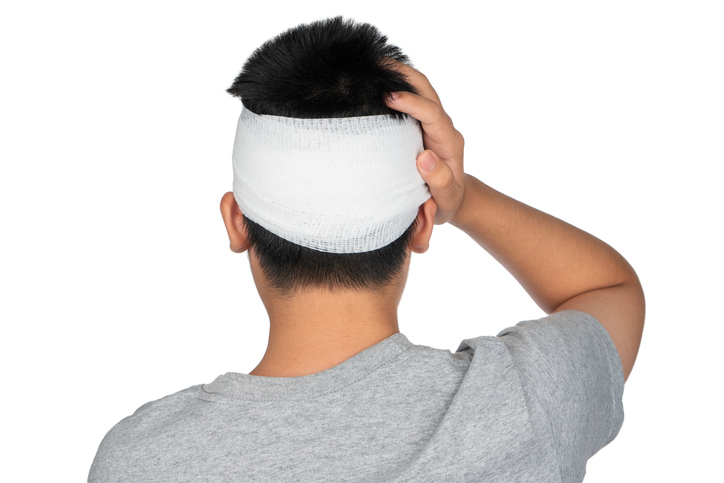Head Injury (Patient information)

Significant trauma to the head can result in various forms of injuries with different presentations:
- Scalp wound — bleeding, boggy swelling (scalp haematoma)
- Skull fracture — localized skull bone pain
- Intracranial (within the skull) bleeding – including bleeding within the brain tissue and/ or bleeding in the surrounding meningeal spaces
- Concussion — traumatic brain injury while brain tissue moving back and forth within the skull. There is no structural damage but the brain function including thinking, memory and ability to concentrate might be affected
- Other more serious but less common injuries – penetrating injuries, diffuse axonal injuries, brain swelling and herniation
Head injury can be classified according to the severity - trivial, mild, moderate and severe. Mild (also called minor) head injury accounts for the majority of cases.
When should I see a doctor after head injury?
One should consider seeking medical advice if any of the following conditions exists:
- Dangerous mechanism of injury
- High velocity trauma
- Any pedestrian or cyclist struck by a motor vehicle
- Any occupant being ejected from a motor vehicle
- Children injury while playing skateboard or scooter, or cycling without a helmet
- Fell from height
- Child < 2 years old: more than 3 feet (1 metre)
- Child 2 years old or adult: more than 5 feet (1.5 metre)
- Unwitnessed event
- High velocity trauma
- Co-existing medical condition
- Aged 65 years or older
- Patient with bleeding tendency or currently on warfarin or other anticoagulants
- Any other symptoms before the accident e.g. chest pain, dizziness
- Any alcohol or drug intake before the accident
- Significant or worrying symptoms after head injury as shown in Table 1.
| Table 1. Significant or worrying symptoms: |
| .loss of consciousness .drowsiness .confusion (disorientation to time, place or person) .appearing dazed or shocked .memory loss .change in personality e.g. bad temper .bleeding or clear fluid from the ear or nose .persistent or severe headache .dizziness .nausea .vomiting (more than once) .seizure .visual disturbance .slurring of speech .weakness or numbness in arms or legs .unsteady gait |
| For children (in addition to the above features)
.not crying after the injury .loss of interest in people or objects .change in their feeding or sleeping pattern .difficulty in awaking from sleep .child not looking well |
What can we provide in the Emergency Department?
- Elicit information on the injury event and identify features suggestive of more serious injuries.
- Discuss with patient or parent(s) whether they need further neuroimaging.
- X-ray skull bone is not recommended due to its limitation in detecting fracture.1
- CT scan of brain is highly accurate in detecting fracture and significant intracranial lesions, so it is the investigation of choice in head injury.
- Your doctor will explain to you how to balance the risks between radiation exposure2 and potential life-threatening intracranial complications.
- Discuss the need for X-ray or CT scan of the neck or facial bone if indicated.
- Discuss the options of light sedation for children (especially children under 5 years of age) before CT scan.
- Discuss the options of neuro-observation in hospital or home observation.
- Choose the appropriate medication for your symptoms.
- Discuss the safety criteria for discharge e.g. any accountable adult to monitor patient?
Post-discharge instructions
- You are advised to monitor any new-onset or progressing symptoms (Table 1) and return to the ED for further assessment if they arise. The period of observation is usually up to 48 hours after the injury.
- There are a number of post-concussive symptoms which may appear after head injury (Table 2)
Table 2
| Thinking/ remembering | Physical |
| .Feeling slowed down .Difficulty in thinking clearly .Difficulty in responding .Difficulty in concentrating .Difficulty in remembering new information | .Headache .Dizziness .Nausea .Feeling tired .Sensitive to noise or light .Blurred vision .Balance problem |
| Emotional | Sleep |
| .Irritability .Nervousness and anxiety .Sadness | .Sleeping more/less than usual .Difficulty in falling asleep |
- During the period of observation, please follow the following recommendations:
| Do’s | Don’ts |
| Get plenty of rest and sleep. | Avoid substances that affect your brain: .Alcohol .Sedatives |
| Take adequate fluid and eat healthily. | Avoid activities that are physically demanding or risky: .Heavy housecleaning .Driving .Operating heavy equipment .Returning to sports within 2 weeks |
| Be accompanied by another adult to observe for high-risk symptoms (Table 1). For children requiring monitoring at night, wake them up every 4 hours in the first 8 hours after injury. | If you have post-concussive symptoms, avoid activities that involve a lot of thinking & concentration: .Watching TV .Playing electronic devices .Working on computers .Reading books |
- The natural course of recovery can be variable
- The majority of patients with mild head injury recover in 2-3 days.
- Around 90% of patients recover in 7-10 days.3
- Some of them may experience post-concussive symptoms up to months, known as post-concussive syndrome.
- Patients having prolonged symptoms for more than 14 days are advised to see doctors for further investigation.
Want to know more?
CDC website with resourceful information on concussion, returning to school or sports
https://www.cdc.gov/headsup/basics/index.html
NHS website on concussion
https://www.nhs.uk/conditions/concussion/
References
- Wong CLW, Lee FT, Chiu LH, Ng MH, Lau CC. No. 12 Guideline for Minor Head Injury. Hospital Authority A&E Clinical Guideline. 2016 May
- Pearce MS et al. Radiation exposure from CT scans in childhood and subsequent risk of leukaemia and brain tumours: a retrospective cohort study. Lancet. 2012 Aug 4;380(9840):499-505. doi: 10.1016/S0140-6736(12)60815-0.
- Victoria Hospital Emergency Department. Adult Sports Concussion Advice. Kirkcaldy (Scotland): National Health Service (UK); 2020





